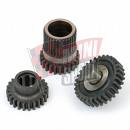- helical-gear
- straight-cut-trans-gear
I was explaining to Brian, the owner of GotTransmissions.com what a straight-cut gear looks like: it’s the classic cog, as seen above It’s a simple gear, but the mating surface is cut perfectly straight which causes noise problems (as it wears the gears fit less precisely with each new tooth coming into mesh, it naturally makes more noise, yet are very strong).
Helical gears are cut on the slant, as the picture on the left indicates. The design and added bearing support surface reduces noise and wear. Helical gears have a longer bearing surface, which reduces the wear problem. Instead of the constant chatter or rattle of gears slopping around on the mainshaft, we have a silky-smooth progression from one tooth to the next.
Constant-mesh Systems
Helical gears are great when they are in mesh, but they are much finer and bringing them together on the fly without damage is not possible. The development of helical gears required the use of a constant mesh system. But how can all the forward gears be in mesh simultaneously without it ending in tears, though? The answer is simple and brilliant – yet difficult to describe!
To set the scene: a gearbox has an input shaft which is connected to the clutch. This is how power goes into the gearbox – the engine turns the input shaft when the clutch is engaged. The gearbox performs its magic and power comes out on an output shaft, which can run at a different speed from the input shaft.
Constant-mesh gearboxes are things of great beauty (if you are an engineering-minded sort). They rely on a strange-looking thing called a counter gear. This is a long gear running on a shaft parallel to the line of the input shaft. Let us imagine a four-speed system such as that fitted to the Camaro.
The mainshaft will have four gears, or more depending on how many speed ranges your vehicle has. The gears are usually in ascending sizes from one end to the other.
Parallel to the mainshaft is the counter shaft. There are the appropriate amount of gears mounted on it to match the gears on the mainshaft. They run in size order opposite to the mainshaft. Each gear is meshed with a sychronizer assembly, that has a slider that connects the apprpriate gears together seemlely in order to make a smooth shift with out double clutching. Each gear has a taper on the end, where a brass ring or a ring lined with a fiber material is attached. As the slider pushes on the brass ring it slows the gear down to match the speed of the next gear. Therfore allowing the gears to mesh smoothly.
Note: The material of the synchro ring dictates what lubrication to use..
That is the end of this post. Continuation article on standard transmission function coming in our next blog post from GotTransmissions.com Blog. Please tune in for the next post or subscribe for free and have it waiting in your email box every day.






